Urban Mountain Waterscapes: The Transformation of Hydro-Social Relations in the Trans-Himalayan Town Leh, Ladakh, India
Abstract
1. Introduction
2. Conceptual Approach
3. Methods
4. Study Area
5. Results
5.1. The Urbanisation of Water
5.2. Development, Modernity and Urban Water Governance
5.3. Civil Society Perspectives on Water Governance
6. Discussion: Hydromentalities and the Production of Uneven Water Citizenships
7. Conclusions
Author Contributions
Funding
Acknowledgments
Conflicts of Interest
References
- Mohanty, S.; Bhagat, R.B. Spatial Pattern of Urbanisation and Urban Growth in Western Himalayan Region in India. In Population, Health and Development: Perspectives on Uttarakhand; Sekher, T.V., Singh, A., Parasuraman, S., Eds.; Academic Foundation: New Delhi, India, 2013; pp. 413–434. ISBN 978-8171889464. [Google Scholar]
- Gondhalekar, D.; Nussbaum, S.; Akhtar, A.; Kebschull, J. Planning Under Uncertainty: Climate Change, Water Scarcity and Health Issues in Leh Town, Ladakh, India. In Sustainable Water Use and Management; Leal Filho, W., Sümer, V., Eds.; Springer International Publishing: Cham, Switzerland, 2015; pp. 293–312. ISBN 978-3-319-12393-6. [Google Scholar]
- McDuie-Ra, D.; Chettri, M. Himalayan Boom Town: Rural–Urban Transformations in Namchi, Sikkim. Dev. Chang. 2018, 49, 1471–1494. [Google Scholar] [CrossRef]
- Kovács, E.K.; Ojha, H.; Neupane, K.R.; Niven, T.; Agarwal, C.; Chauhan, D.; Dahal, N.; Devkota, K.; Guleria, V.; Joshi, T.; et al. A Political Ecology of Water and Small-town Urbanisation across the Lower Himalayas. Geoforum 2019. [Google Scholar] [CrossRef]
- Prakash, A.; Molden, D. Editorial: Mapping Challenges for Adaptive Water Management in Himalayan Towns. Water Policy 2020, 22, 1–8. [Google Scholar] [CrossRef]
- Dame, J.; Schmidt, S.; Müller, J.; Nüsser, M. Urbanisation and Socio-ecological Challenges in High Mountain Towns: Insights from Leh (Ladakh), India. Landsc. Urban Plan. 2019, 189, 189–199. [Google Scholar] [CrossRef]
- Wang, Y.; Wu, N.; Kunze, C.; Long, R.; Perlik, M. Drivers of Change to Mountain Sustainability in the Hindu Kush Himalaya. In The Hindu Kush Himalaya Assessment: Mountains, Climate Change, Sustainability and People; Wester, P., Mishra, A., Mukherji, A., Shrestha, A.B., Eds.; Springer: Cham, Germany, 2019; pp. 17–56. ISBN 978-3-319-92287-4. [Google Scholar]
- Geneletti, D.; Dawa, D. Environmental Impact Assessment of Mountain Tourism in Developing Regions: A Study in Ladakh, Indian Himalaya. Environ. Impact Assess. Rev. 2009, 29, 229–242. [Google Scholar] [CrossRef]
- Pandit, M.K.; Manish, K.; Koh, L.P. Dancing on the Roof of the World: Ecological Transformation of the Himalayan Landscape. BioScience 2014, 64, 980–992. [Google Scholar] [CrossRef]
- Krishnan, R.; Shrestha, A.B.; Ren, G.; Rajbhandari, R.; Saeed, S.; Sanjay, J.; Syed, M.A.; Vellore, R.; Xu, Y.; You, Q.; et al. Unravelling Climate Change in the Hindu Kush Himalaya: Rapid Warming in the Mountains and Increasing Extremes. In The Hindu Kush Himalaya Assessment: Mountains, Climate Change, Sustainability and People; Wester, P., Mishra, A., Mukherji, A., Shrestha, A.B., Eds.; Springer International Publishing: Cham, Germany, 2019; pp. 57–97. ISBN 978-3-319-92288-1. [Google Scholar]
- Gandy, M. Landscapes of Disaster: Water, Modernity, and Urban Fragmentation in Mumbai. Environ. Plan. A 2008, 40, 108–130. [Google Scholar] [CrossRef]
- McFarlane, C. Governing the Contaminated City: Infrastructure and Sanitation in Colonial and Post-Colonial Bombay. Int. J. Urban Reg. Res. 2008, 32, 415–435. [Google Scholar] [CrossRef]
- Truelove, Y. (Re-)Conceptualizing Water Inequality in Delhi, India Through a Feminist Political Ecology Framework. Geoforum 2011, 42, 143–152. [Google Scholar] [CrossRef]
- Graham, S.; Desai, R.; McFarlane, C. Water Wars in Mumbai. Public Cult. 2013, 25, 115–141. [Google Scholar] [CrossRef]
- Anand, N. Hydraulic City. Water and the Infrastructures of Citizenship in Mumbai; Duke University Press: Durham, UK, 2017; ISBN 9780822362548. [Google Scholar]
- Aggarwal, R. Beyond Lines of Control. Performance and Politics on the Disputed Borders of Ladakh, India; Duke University Press: Durham, UK, 2004; ISBN 978-0-8223-3414-9. [Google Scholar]
- Véron, R. Small Cities, Neoliberal Governance and Sustainable Development in the Global South: A Conceptual Framework and Research Agenda. Sustainability 2010, 2, 2833–2848. [Google Scholar] [CrossRef]
- Nüsser, M. Socio-hydrology: A New Perspective on Mountain Waterscapes at the Nexus of Natural and Social Processes. Mt. Res. Dev. 2017, 37, 518–520. [Google Scholar] [CrossRef]
- Census of India. District Census Handbook Leh (Ladakh). Village and Town Wise Primary Census Abstract (PCA). Jammu and Kashmir, Series-02, Part XII-B. Available online: http://www.censusindia.gov.in/2011census/dchb/0103_PART_B_DCHB_LEH%20(LADAKH).pdf (accessed on 11 December 2018).
- Schmidt, S.; Nüsser, M. Changes of High Altitude Glaciers in the Trans-Himalaya of Ladakh over the Past Five Decades (1969–2016). Geosciences 2017, 7, 27. [Google Scholar] [CrossRef]
- Beck, H.E.; Zimmermann, N.E.; McVicar, T.R.; Vergopolan, N.; Berg, A.; Wood, E.F. Present and Future Köppen-Geiger Climate Classification Maps at 1-km Resolution. Sci. Data 2018, 5, 1–12. [Google Scholar] [CrossRef] [PubMed]
- Chevuturi, A.; Dimri, A.P.; Thayyen, R. Climate Change over Leh (Ladakh), India. Theor. Appl. Climatol. 2018, 131, 531–545. [Google Scholar] [CrossRef]
- Ziegler, A.D.; Cantarero, S.I.; Wasson, R.J.; Srivastava, P.; Spalzin, S.; Chow, W.T.L.; Gillen, J. A Clear and Present Danger: Ladakh’s Increasing Vulnerability to Flash Floods and Debris Flows. Hydrol. Process. 2016, 30, 4214–4223. [Google Scholar] [CrossRef]
- Community Resilience, Universities and Engaged Research for Today’s World; Madsen, W., Costigan, L., McNicol, S., Eds.; Palgrave Macmillan: London, UK, 2015; ISBN 9781137481054. [Google Scholar]
- van Zandt, S.; Masterson, J.; Newman, G.; Meyer, M. (Eds.) Engaged Research for Community Resilience to Climate Change; Elsevier: Amsterdam, The Netherlands, 2020; ISBN 978-0-12-815575-2. [Google Scholar]
- Swyngedouw, E. Social Power and the Urbanization of Water. Flows of Power; Oxford University Press: Oxford, UK; New York, NY, USA, 2004; ISBN 0-19-823391-4. [Google Scholar]
- Karpouzoglou, T.; Vij, S. Waterscape: A Perspective for Understanding the Contested Geography of Water. Wiley Interdiscip. Rev. Water 2017, 4, e1210. [Google Scholar] [CrossRef]
- Budds, J.; Hinojosa-Valencia, L. Restructuring and Rescaling Water Governance in Mining Contexts: the Co-production of Waterscapes in Peru. Water Altern. 2012, 5, 119–137. [Google Scholar]
- Lankford, B. Infrastructure Hydromentalities; Water Sharing, Water Control and Water (In)Security. In Water Security; Lankford, B., Bakker, K., Zeitoun, M., Conway, D., Eds.; Taylor & Francis Ltd.: London, UK, 2013; pp. 256–272. ISBN 9780415534710. [Google Scholar]
- Hellberg, S. The Biopolitics of Water. Governance, Scarcity and Populations; Routledge: Abingdon, UK; New York, NY, USA, 2018; ISBN 978-1-138-74075-4. [Google Scholar]
- Foucault, M. Discipline and Punish. The Birth of the Prison; Recording for the Blind & Dyslexic: Princeton, NJ, USA, 2007; ISBN 0-679-75255-2. [Google Scholar]
- Huxley, M. Geographies of Governmentality. In Space, Knowledge and Power: Foucault and Geography; Crampton, J.W., Elden, S., Eds.; Ashgate: Aldershot, UK; Burlington, NJ, USA, 2007; pp. 185–204. ISBN 978-0-7546-4655-6. [Google Scholar]
- Hellberg, S. Scarcity as a Means of Governing: Challenging Neoliberal Hydromentality in the Context of the South African Drought. Environ. Plan. E Nat. Space 2019, 2514848619853551. [Google Scholar] [CrossRef]
- Mele, C. The Materiality of Urban Discourse: Rational Planning in the Restructuring of the Early Twentieth-Century Ghetto. Urban Aff. Rev. 2000, 35, 628–648. [Google Scholar] [CrossRef]
- Yates, J.S.; Harris, L.M.; Wilson, N.J. Multiple Ontologies of Water: Politics, Conflict and Implications for Governance. Environ. Plan. D Soc. Space 2017, 35, 797–815. [Google Scholar] [CrossRef]
- Rodina, L.; Harris, L.M. Water Services, Lived Citizenship, and Notions of the State in Marginalised Urban Spaces: The Case of Khayelitsha, South Africa. Water Altern. 2016, 9, 336–355. [Google Scholar]
- Gregory, D.; Johnston, R.; Pratt, G.; Watts, M.; Whatmore, S.J. The Dictionary of Human Geography, 5th ed.; Wiley-Blackwell: Malden, MA, USA, 2009; ISBN 978-1-4051-3287-9. [Google Scholar]
- Denzin, N.K. Sociological methods. a sourcebook; Butterworth: London, UK, 1970; ISBN 0408701250. [Google Scholar]
- Kotus, J.; Rzeszewski, M. Methodological Triangulation In Movement Pattern Research. Quaest. Geogr. 2015, 34, 25–37. [Google Scholar] [CrossRef]
- Lavrakas, P. Probability Proportional to Size (PPS) Sampling. In Encyclopedia of Survey Research Methods; Lavrakas, P., Ed.; Sage Publications, Inc.: Thousand Oaks, CA, California, 2008; ISBN 9781412918084. [Google Scholar]
- Fantini, E. Picturing Waters: A Review of Photovoice and Similar Participatory Visual Research on Water Governance. Wiley Interdiscip. Rev. Water 2017, 4, e1226. [Google Scholar] [CrossRef]
- Maclean, K.; Woodward, E. Photovoice Evaluated: An Appropriate Visual Methodology for Aboriginal Water Resource Research. Geogr. Res. 2013, 51, 94–105. [Google Scholar] [CrossRef]
- Harper, D. Talking about pictures: A case for photo elicitation. Vis. Stud. 2002, 17, 13–26. [Google Scholar] [CrossRef]
- Archer, D.R.; Fowler, H.J. Spatial and Temporal Variations in Precipitation in the Upper Indus Basin, Global Teleconnections and Hydrological Implications. Hydrol. Earth Syst. Sci. 2004, 8, 47–61. [Google Scholar] [CrossRef]
- Nüsser, M.; Schmidt, S.; Dame, J. Irrigation and Development in the Upper Indus Basin: Characteristics and Recent Changes of a Socio-hydrological System in Central Ladakh, India. Mt. Res. Dev. 2012, 32, 51–61. [Google Scholar] [CrossRef]
- Dhiman, S.C. Rejuvenation of Aquifers. In Water Governance: Challenges and Prospects; Singh, A., Saha, D., Tyagi, A.C., Eds.; Springer: Singapore, 2019; pp. 187–204. ISBN 978-981-13-2700-1. [Google Scholar]
- Nüsser, M.; Dame, J.; Kraus, B.; Baghel, R.; Schmidt, S. Socio-hydrology of “Artificial Glaciers” in Ladakh, India: Assessing Adaptive Strategies in a Changing Cryosphere. Reg. Environ. Chang. 2019, 19, 1327–1337. [Google Scholar] [CrossRef]
- Hock, R.; Rasul, G.; Adler, C.; Cáceres, B.; Gruber, S.; Hirabayashi, Y.; Jackson, M.; Kääb, A.; Kang, S.; Kutuzov, S.; et al. High Mountain Areas. In Special Report on the Ocean and Cryosphere in a Changing Climate; Pörtner, H.-O., Roberts, D.C., Masson-Delmotte, V., Zhai, P., Tignor, M., Poloczanska, E., Mintenbeck, K., Alegría, A., Nicolai, M., Okem, A., Eds.; IPCC: Geneva Switzerland, 2019; pp. 131–202. [Google Scholar]
- Morup, T.; Chodon, R. The Old Town Leh, Ladakh. Available online: https://www.sahapedia.org/the-old-town-leh-ladakh-0 (accessed on 3 April 2020).
- Dame, J.; Nüsser, M. Development Perspectives in Ladakh, India. Geogr. Rundsch. Int. Ed. 2008, 4, 20–27. [Google Scholar]
- Gagné, K. Building a Mountain Fortress for India: Sympathy, Imagination and the Reconfiguration of Ladakh into a Border Area. South Asia J. South Asian Stud. 2017, 40, 222–238. [Google Scholar] [CrossRef]
- Baghel, R.; Nüsser, M. Securing the Heights: The Vertical Dimension of the Siachen Conflict Between India and Pakistan in the Eastern Karakoram. Political Geogr. 2015, 48, 24–36. [Google Scholar] [CrossRef]
- Tourism Department. Month Wise Tourist Arrival Statement for the Year 2018; Unpublished; Tourism Department: Leh, Ladakh, 2019. [Google Scholar]
- Tetra Tech. Detailed Project Report for Sewerage System of Leh Town; Unpublished; 2009. [Google Scholar]
- Gondhalekar, D.; Akhtar, A. Down the Drain or Back to the Roots? Political Ecology of the Water-Energy-Food Nexus Visualized Using GIS in Leh Town, Ladakh, India. In Projections 11 - Global Ecologies: Politics, Planning, and Design; Goh, K., Chu, E., Eds.; MIT Department of Urban Studies and Planning: Cambridge, MA, USA, 2015; pp. 77–98. [Google Scholar]
- Ladakh Autonomous Hill Development Council (LAHDC). In Ladakh 2025 Vision Document; Leh, Ladakh, 2005. Available online: https://cdn.s3waas.gov.in/s3291597a100aadd814d197af4f4bab3a7/uploads/2018/06/2018061732.pdf (accessed on 18 December 2019).
- Kooy, M. Developing Informality: The Production of Jakarta’s Urban Waterscape. Water Altern. 2014, 7, 35–53. [Google Scholar]
- Kaika, M. City of Flows. Modernity, Nature, and the City; Routledge: New York, NY, USA; Abingdon, UK, 2005; ISBN 0-415-94715-4. [Google Scholar]
- Gandy, M. Rethinking Urban Metabolism: Water, Space and the Modern City. City 2004, 8, 363–379. [Google Scholar] [CrossRef]
- Schwaller, C. Assessment of the Impact of On-site Sanitation Systems on Groundwater Quality in Leh Town, India. Master Thesis, Technical University of Munich, Munich, Germany, 2018. [Google Scholar]
- Ternes, B. Groundwater Citizenship and Water Supply Awareness: Investigating Water-Related Infrastructure and Well Ownership. Rural Sociol. 2018, 83, 347–375. [Google Scholar] [CrossRef]
- In PM Narendra Modi’s Speech, a Big Push to Domestic Tourism. Hindustan Times [Online]. 16 August 2019. Available online: https://www.hindustantimes.com/india-news/in-modi-speech-a-big-push-to-domestic-tourism/story-0wfJuK0JsjX3fDXwXo05vM.html (accessed on 16 August 2019).
- Scott, C.A.; Zhang, F.; Mukherji, A.; Immerzeel, W.; Mustafa, D.; Bharati, L. Water in the Hindu Kush Himalaya. In The Hindu Kush Himalaya Assessment: Mountains, Climate Change, Sustainability and People; Wester, P., Mishra, A., Mukherji, A., Shrestha, A.B., Eds.; Springer: Cham, Germany, 2019; pp. 257–299. ISBN 978-3-319-92287-4. [Google Scholar]
- Rao, N.; Suresh, K.T. Domestic Tourism in India. In The Native Tourist: Mass Tourism Within Developing Countries; Ghimire, K.B., Ed.; Earthscan: London, UK; New York, NY, USA, 2001; ISBN 9781853838040. [Google Scholar]
- Perlik, M. The Spatial and Economic Transformation of Mountain Regions. Landscapes as Commodities; Routledge: Abingdon, UK; New York, NY, USA, 2019; ISBN 9781138784086. [Google Scholar]
- Singh, S.; Tanvir Hassan, S.M.; Hassan, M.; Bharti, N. Urbanisation and Water Insecurity in the Hindu Kush Himalaya: Insights from Bangladesh, India, Nepal and Pakistan. Water Policy 2019, 26, 179. [Google Scholar] [CrossRef]
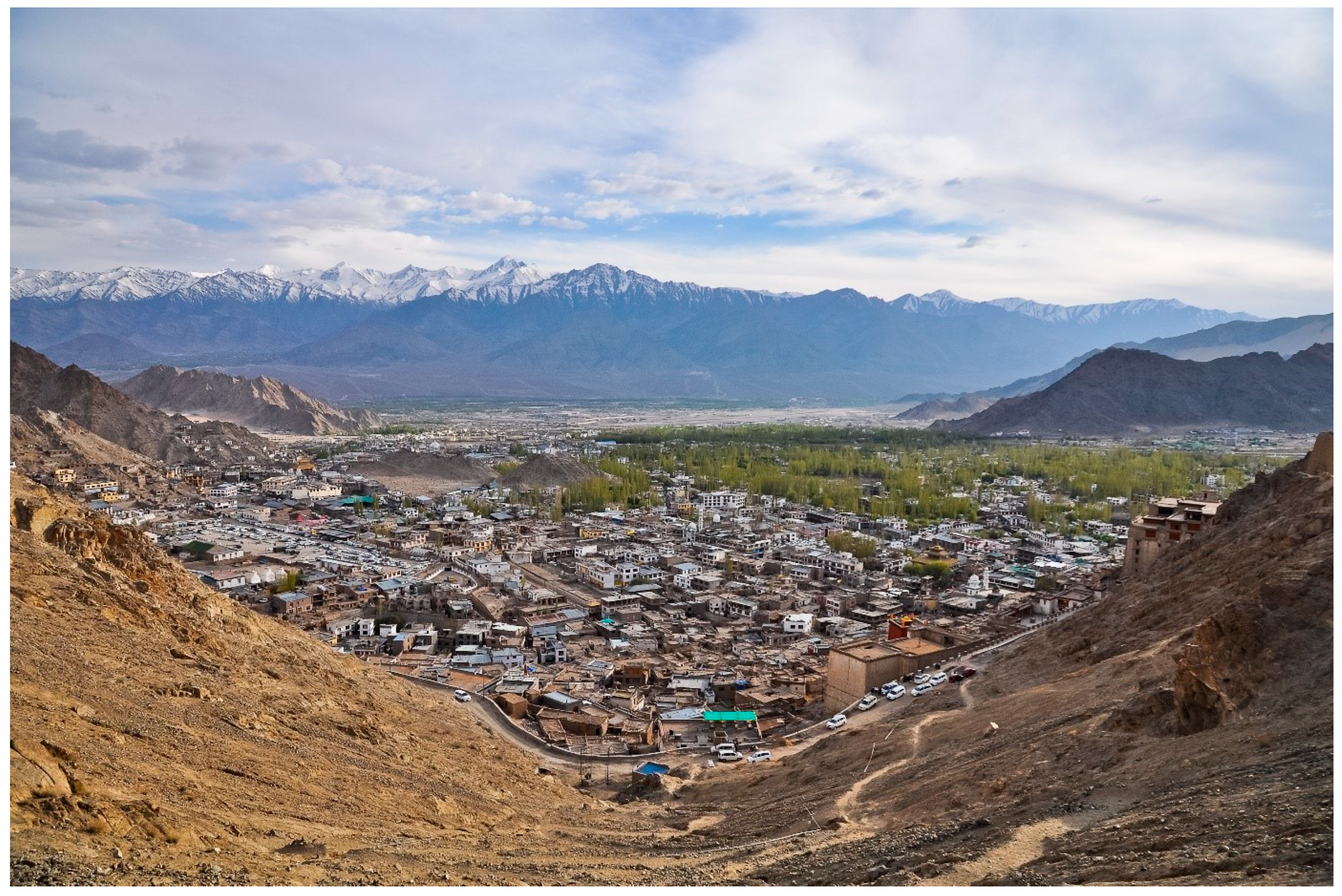
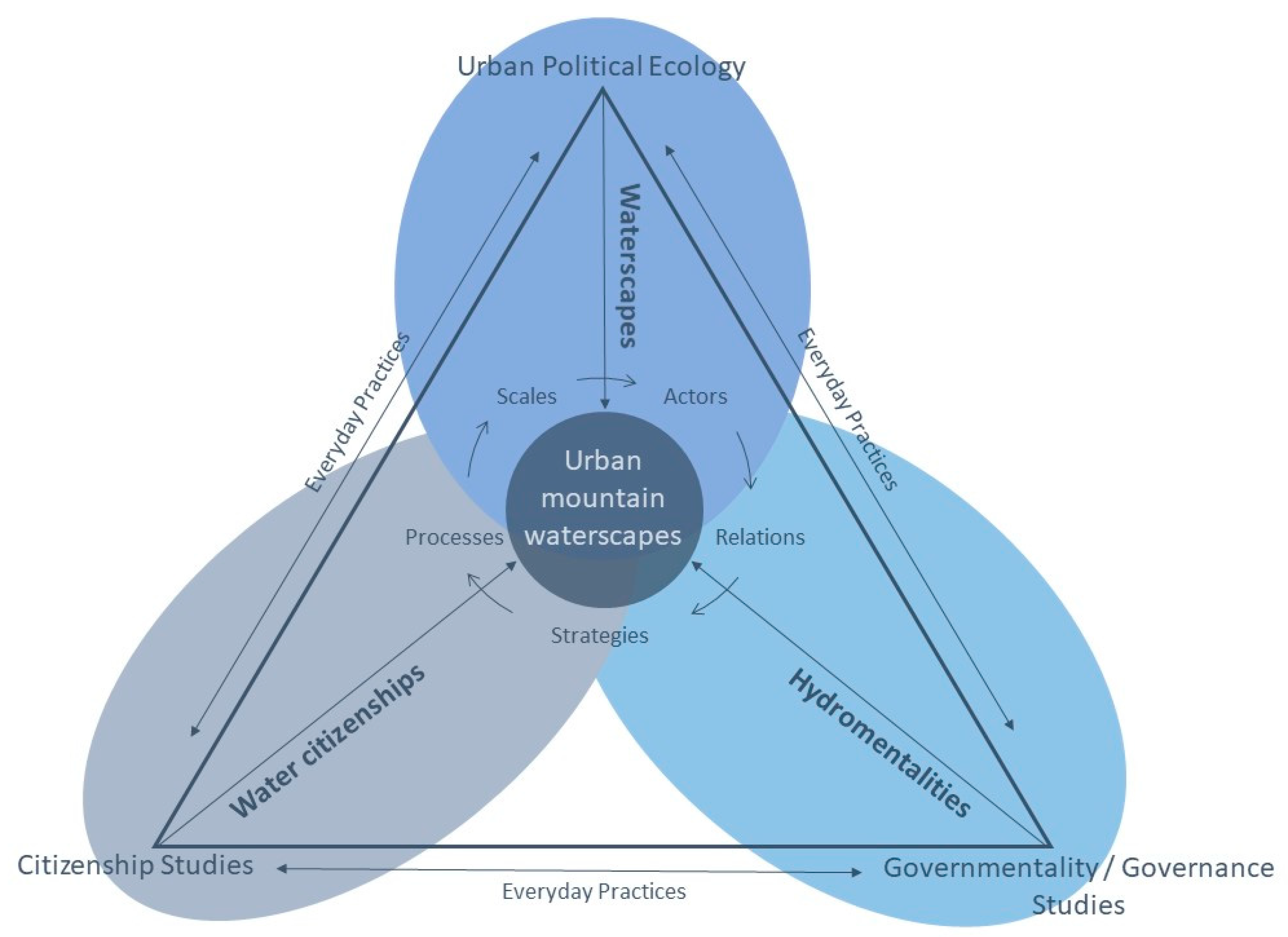
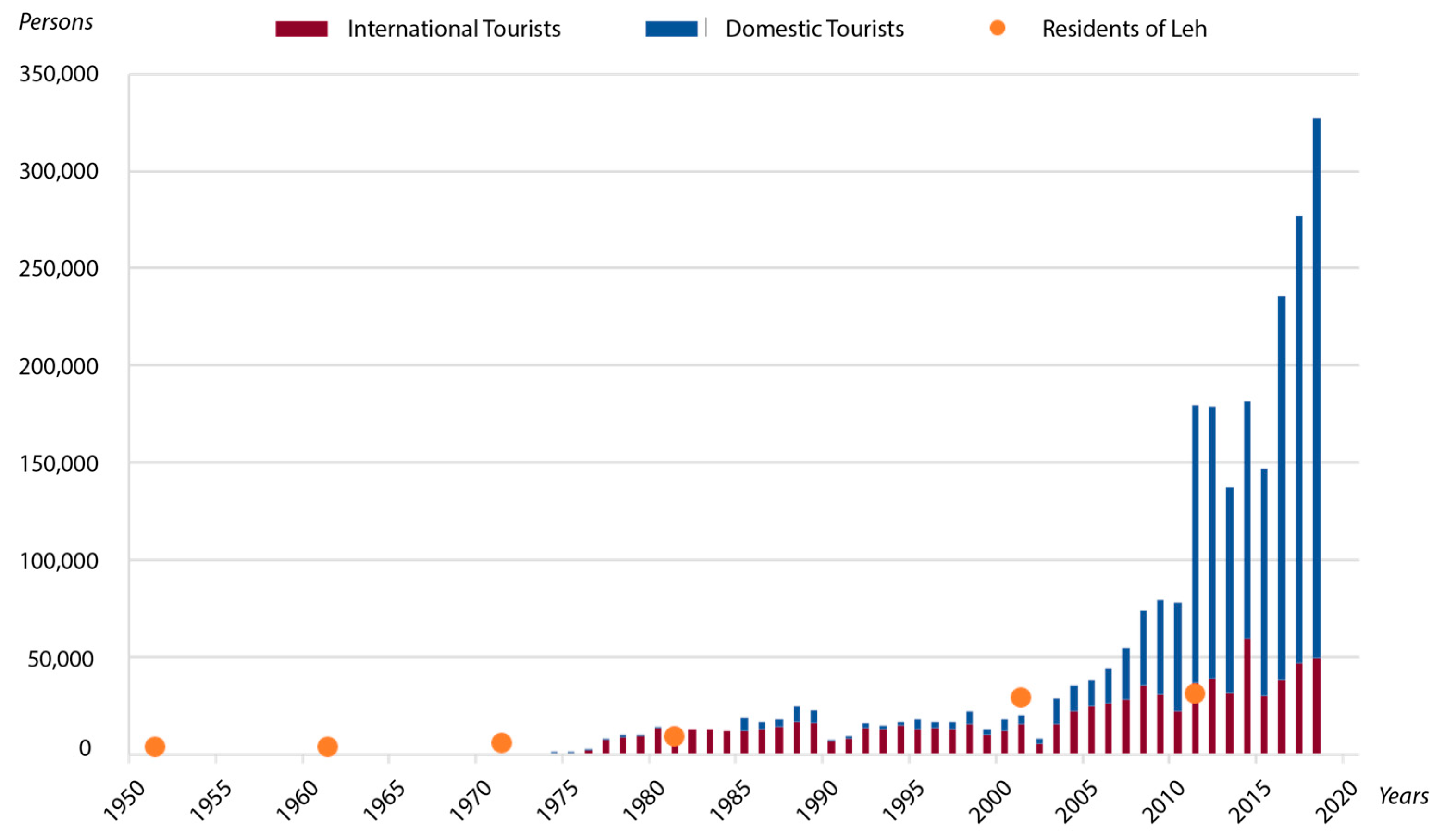
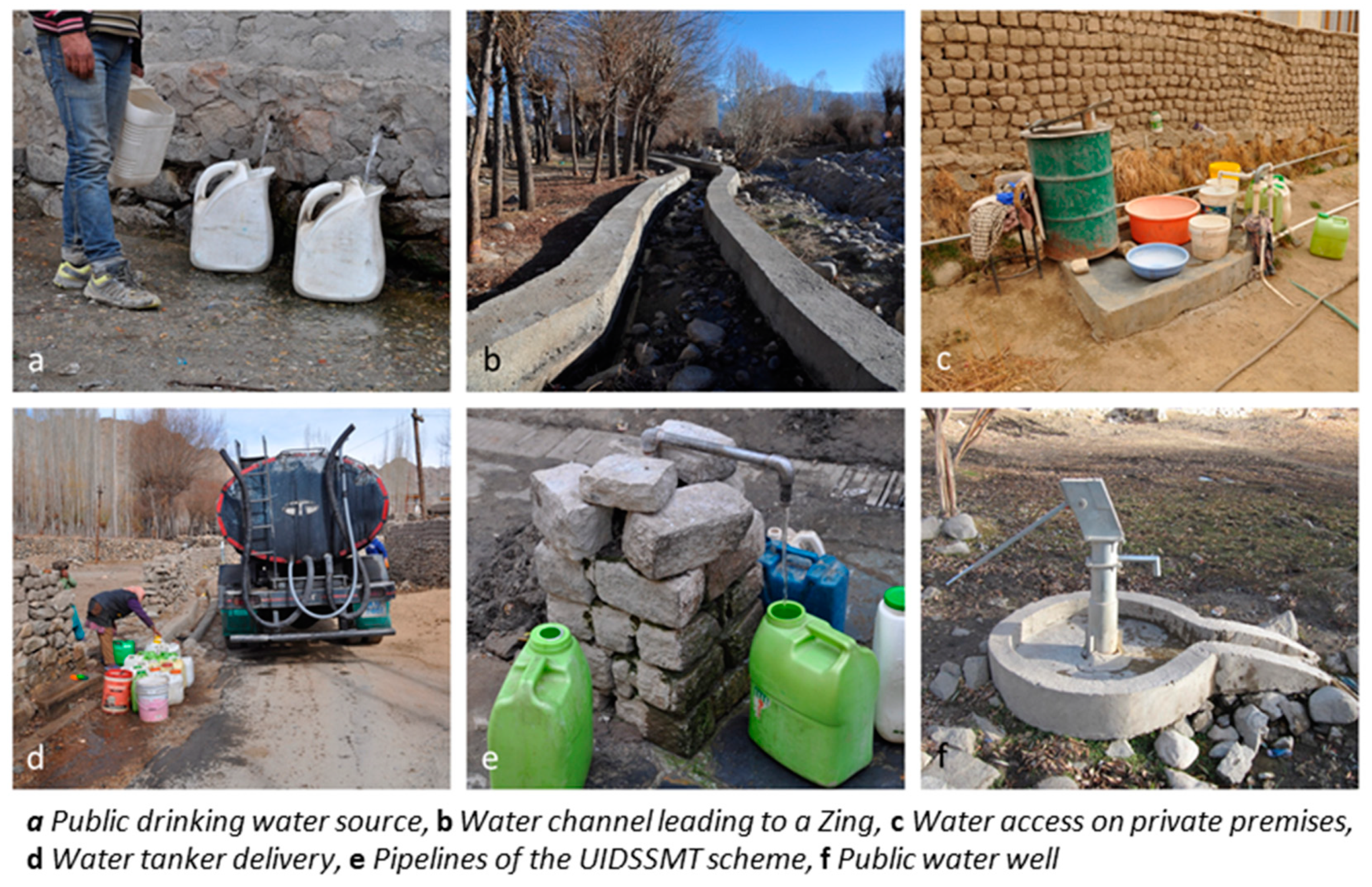
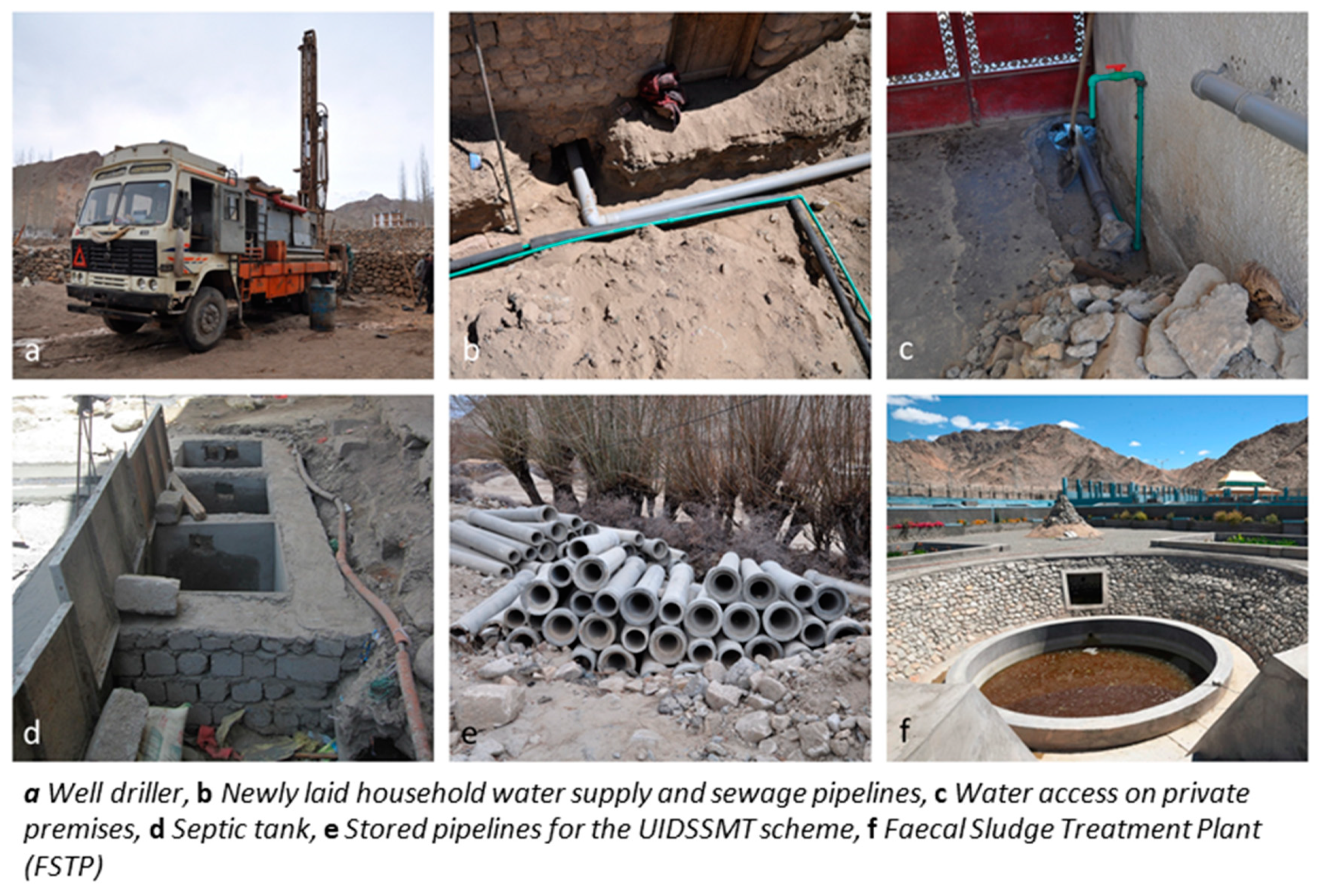
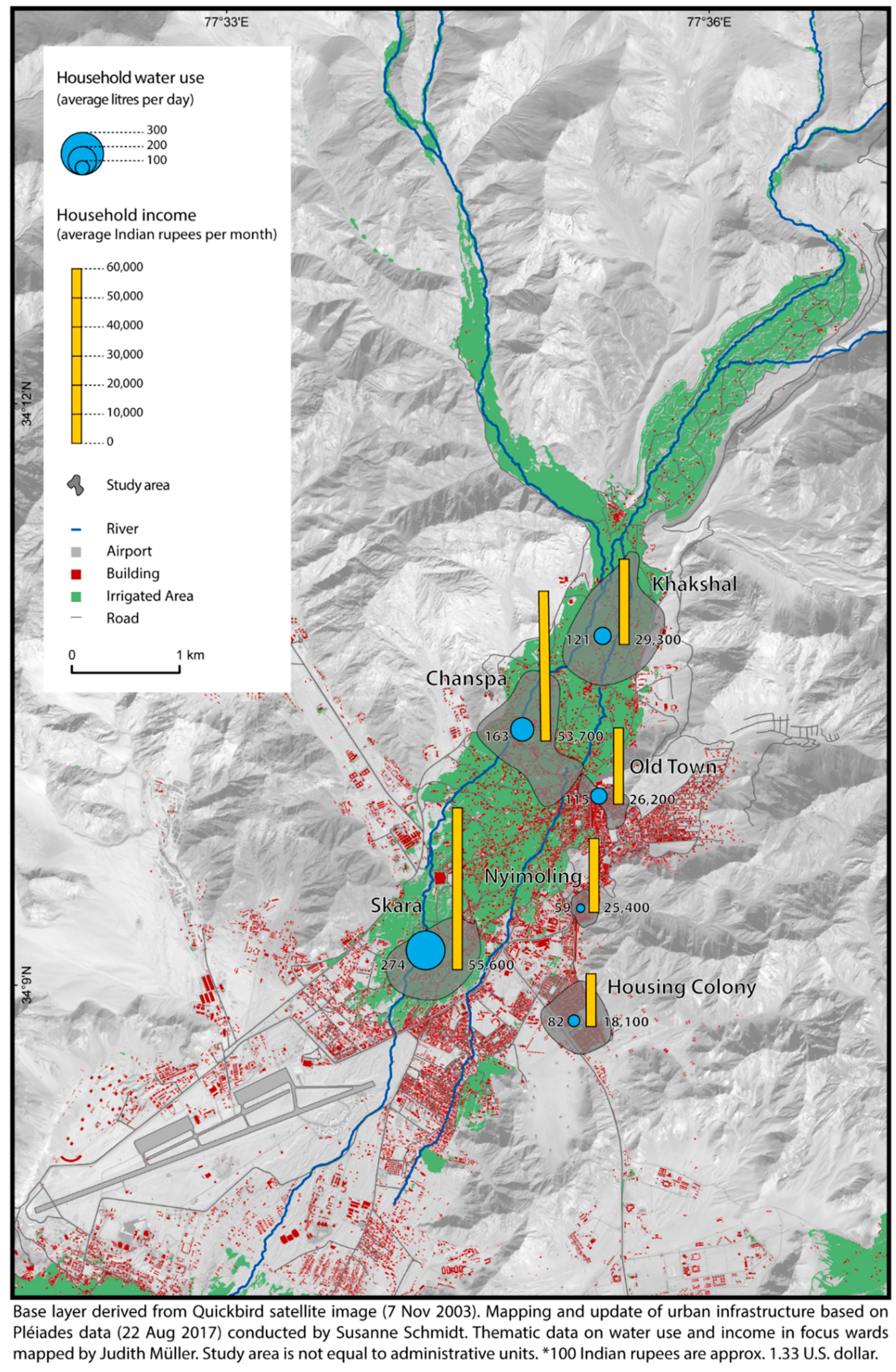
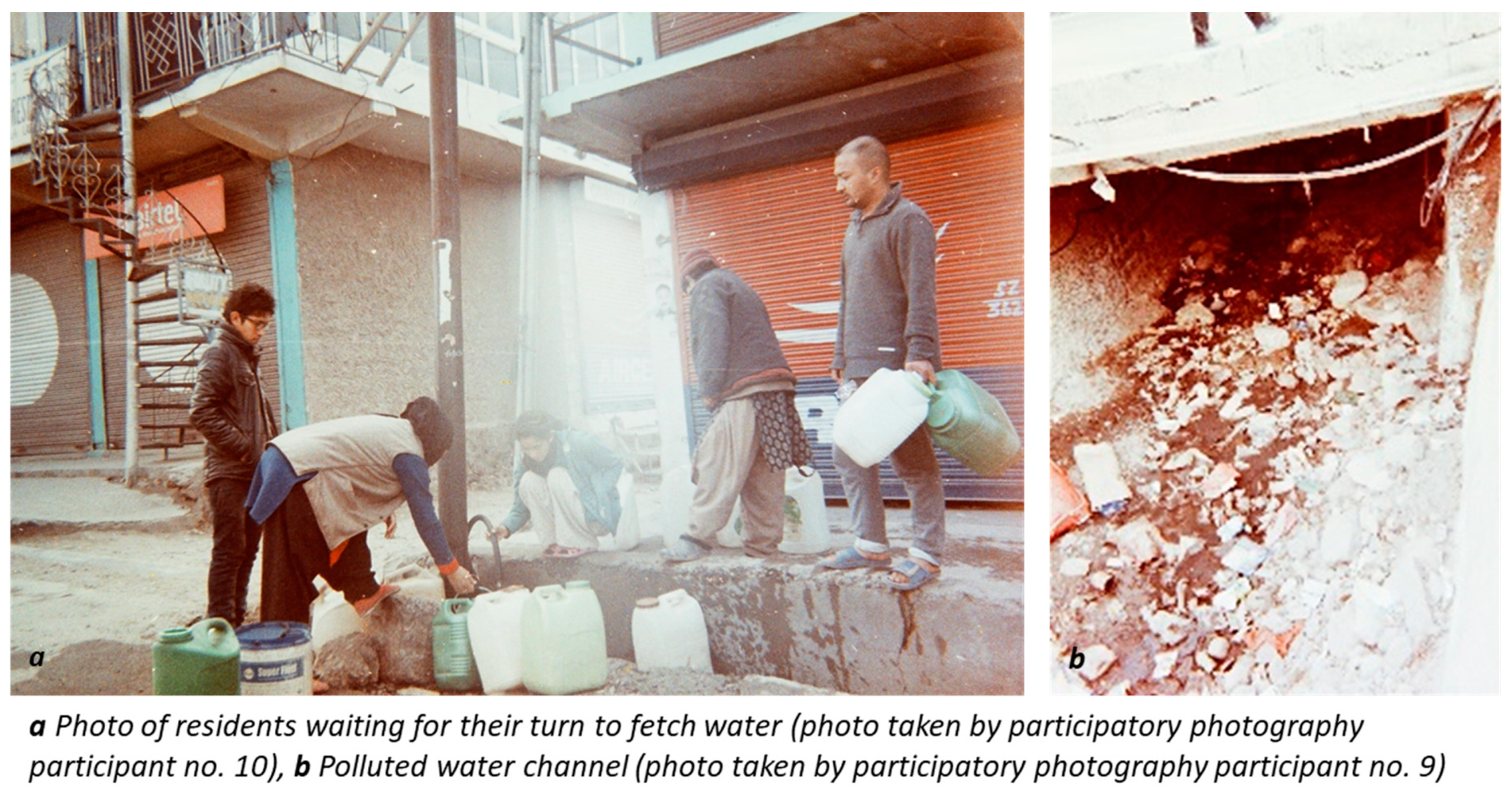
© 2020 by the authors. Licensee MDPI, Basel, Switzerland. This article is an open access article distributed under the terms and conditions of the Creative Commons Attribution (CC BY) license (http://creativecommons.org/licenses/by/4.0/).
Share and Cite
Müller, J.; Dame, J.; Nüsser, M. Urban Mountain Waterscapes: The Transformation of Hydro-Social Relations in the Trans-Himalayan Town Leh, Ladakh, India. Water 2020, 12, 1698. https://doi.org/10.3390/w12061698
Müller J, Dame J, Nüsser M. Urban Mountain Waterscapes: The Transformation of Hydro-Social Relations in the Trans-Himalayan Town Leh, Ladakh, India. Water. 2020; 12(6):1698. https://doi.org/10.3390/w12061698
Chicago/Turabian StyleMüller, Judith, Juliane Dame, and Marcus Nüsser. 2020. "Urban Mountain Waterscapes: The Transformation of Hydro-Social Relations in the Trans-Himalayan Town Leh, Ladakh, India" Water 12, no. 6: 1698. https://doi.org/10.3390/w12061698
APA StyleMüller, J., Dame, J., & Nüsser, M. (2020). Urban Mountain Waterscapes: The Transformation of Hydro-Social Relations in the Trans-Himalayan Town Leh, Ladakh, India. Water, 12(6), 1698. https://doi.org/10.3390/w12061698




